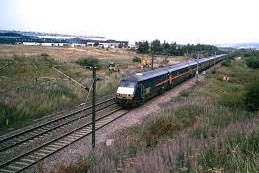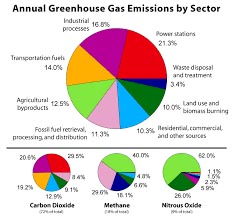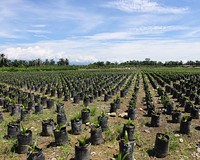
Accelerating into the dangerous curve of deforestation and climate change
As this article goes to publication in the Greater North Texas Orchid Society (GNTOS) newsletter, the news of the Amtrak train in Philadelphia accelerating into the curve is all over the news. How could such a tragedy occur when the technology for preventing it is readily available? In the coming days and weeks more information will certainly give us a clearer explanation. In the meantime, however, this incident can serve as a valuable learning tool when we regard it as an analogy with conservation. We have a great deal of technology and information about how we can slow the effects of climate change and prevent the loss of human life and property, as well as the loss of countless species of plants and animals. So why is it, that despite all this knowledge available to us on the condition of our planet, we are accelerating into the curve of environmental destruction rather than pulling back on the throttle?
 We know, for example, that our heavy use of automobiles is adding many tons of CO2 to our atmosphere, thereby exacerbating the greenhouse effect. (See a brief video about how the greenhouse effect works here). One would think, then, that we would be doing all we can to reduce the amount of CO2 we generate. Unfortunately, we are doing just the opposite. Recent news stories report that the demand for hybrid automobiles is decreasing, while SUV sales are increasing, all because lower gas prices the SUV’s more popular. The slight improvements in fuel efficiencies on many SUV models are really beside the point. We give this phenomenon a cute name like “One and Done” to explain our fling with the hybrids. When will it be trendy to be part of the solution, and very un-cool to be part of the problem? And how is this preference for SUV’s going to get us off of hydrocarbons by 2050?
We know, for example, that our heavy use of automobiles is adding many tons of CO2 to our atmosphere, thereby exacerbating the greenhouse effect. (See a brief video about how the greenhouse effect works here). One would think, then, that we would be doing all we can to reduce the amount of CO2 we generate. Unfortunately, we are doing just the opposite. Recent news stories report that the demand for hybrid automobiles is decreasing, while SUV sales are increasing, all because lower gas prices the SUV’s more popular. The slight improvements in fuel efficiencies on many SUV models are really beside the point. We give this phenomenon a cute name like “One and Done” to explain our fling with the hybrids. When will it be trendy to be part of the solution, and very un-cool to be part of the problem? And how is this preference for SUV’s going to get us off of hydrocarbons by 2050?
I mention this as just an example of the role we consumers play in what happens to our earth. As hard as it is to understand, each and every one of our actions is important. Are we pushing on the throttle or on the brake? Are we waiting for the engineer to throttle back or will we notice the speed and pull the emergency cord in our passenger car?
I am currently reading the World Wildlife Fund (WWF) Living Forest Report. As many of you may know, loss of habitat is a topic I cover frequently as critical to orchid conservation. The WWF report highlights a project called “Zero Net Deforestation and Forest Degradation (ZNDD)”. To give a reference point, an area the size of 5 football field is cleared every 10 seconds for all forests worldwide. That comes to an area the size of Costa Rica each year. Just for perspective, that means 43,200 football fields every single day. Please pause for just a moment, close your eyes, and imagine how many trees that might be, and how many animals lose their habitat. And consider also, how this affects the e arth’s ability to deal with the increasing CO2 levels, when we lose the trees which breathe in CO2 and breathe out the oxygen we need for ourselves.
Here are three excerpts of the WWF Living Forest Report:
Achieving ZNDD by 2020 depends on preventing further forest loss caused by poor planning, weak governance, excessive consumption, inequitable or insecure land tenure and user rights, unregulated or illegal forest clearing, poor forest management, inefficient agriculture and over-harvesting of fuelwood.
WWF envisions a world where humanity lives within the Earth’s ecological limits and shares its resources equitably.
In the longer term, maintaining near zero forest loss will require forestry and farming practices that produce more yield with less land, less water and less pollution, along with new consumption patterns that meet the needs of the poor while eliminating waste and over-consumption by the affluent.
The ideas above are representative of so many reports and well-crafted strategies that depend on a myriad of laws and enforcement efforts; all efforts over which we citizens have little control. But the third idea puts the control of the forests in the underdeveloped nations squarely in the hands of the developed countries, and that means each and every one of us consumers will need to do our part to turn a concept into reality. The market system really can work toward the end we desire. If we refuse to purchase goods which contribute heavily to climate change, the manufacture and sale of those goods will cease. We can make that decision.
Farming with less land, water and pollution eliminates animal products as the mainstay diet. Raising cattle for consumption is only about 10% efficient use of land and water, and is known for its heavy contribution to pollution, mainly in the form of vastly destructive methane gas. As a consumer, are you still demanding your steaks and hamburgers? Or are you willing to move to a plant-based diet, which is healthier not only for the earth, but for you as well?
 Even more insidious than animal agriculture is the world demand for palm oil. This substance is found in a variety of foods, such ice cream, snacks, chips and many of the engineered “edible food-like substances” to quote noted food author Michael Pollan. His documentary film “In Defense of Food” is highly recommended. For a mini-course on how to change to a sustainable diet, see this Michael Pollan video. It is both entertaining and educational.
Even more insidious than animal agriculture is the world demand for palm oil. This substance is found in a variety of foods, such ice cream, snacks, chips and many of the engineered “edible food-like substances” to quote noted food author Michael Pollan. His documentary film “In Defense of Food” is highly recommended. For a mini-course on how to change to a sustainable diet, see this Michael Pollan video. It is both entertaining and educational.
Palm oil plantations have accelerated their expansion into Indonesia and Borneo over the last decade, wiping out vast areas of rain forest and natural habitat in these countries. Knowing the harm caused by the use of palm oil, will we be motivated to read labels and avoid this ingredient? Here are some tips for avoiding palm oil products.
We consumers have the power to pull back on the throttle of excessive and unnecessary consumption. We have a clear choice here. We can be part of the solution by making wise consumption choices, or we can continue to accelerate into the curve of destruction.